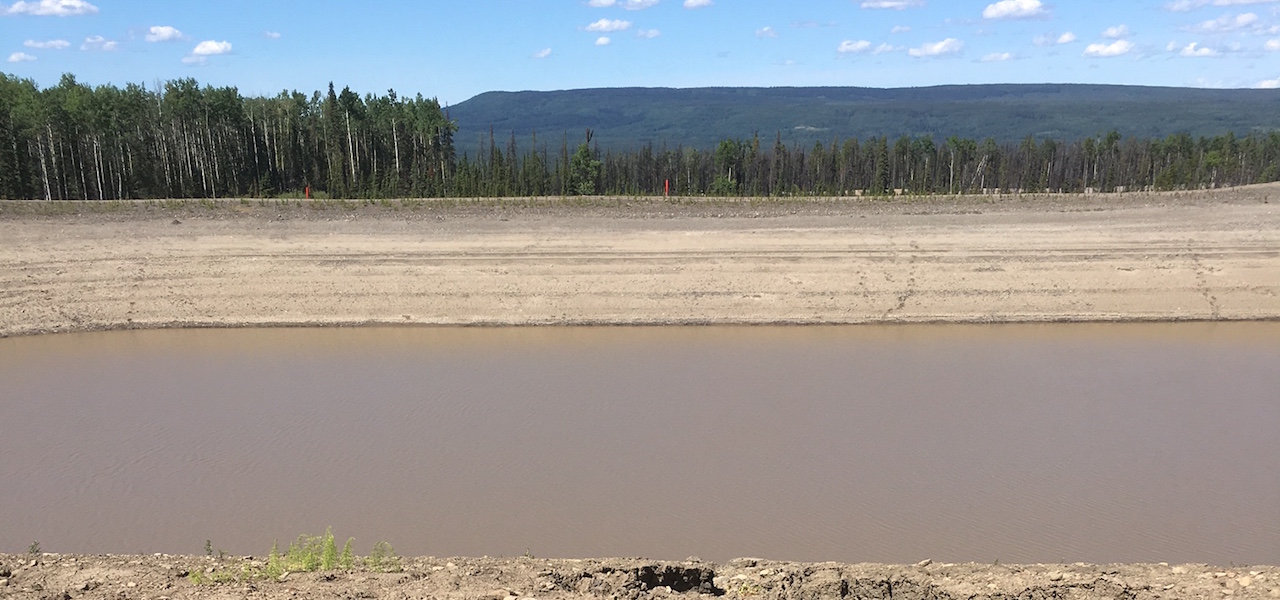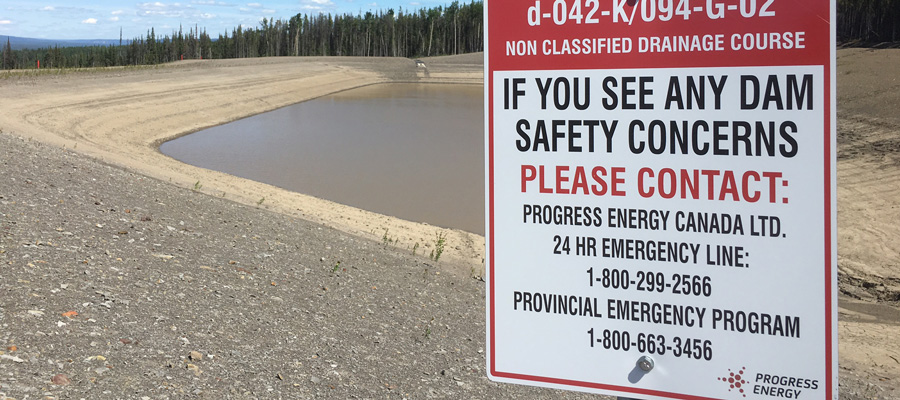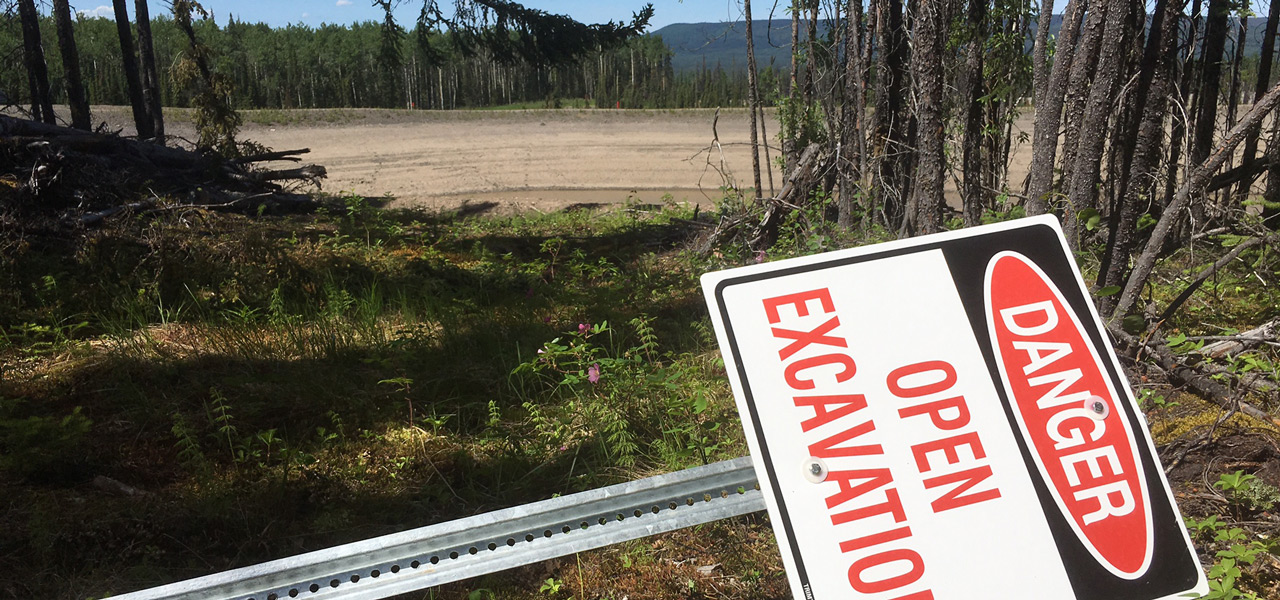Dangerous precedent: Petronas subsidiary gets free pass after building unlicensed fracking dams
In a decision without precedent in its 25 years of existence, British Columbia’s Environmental Assessment Office (EAO) has told Progress Energy that two massive unauthorized dams that it built will not have to undergo environmental assessments.
The decision comes after the company made an audacious request to the EAO to have the two dams declared retroactively exempt from review—a request that was quietly granted by the Province’s self-described “neutral” environmental regulator on July 17.
The exemption means Progress Energy is spared having the controversial dams subject to costly, public and potentially embarrassing reviews. The dams are described as “illegal works” in documents released by the EAO in response to a Freedom of Information request from the Canadian Centre for Policy Alternatives (CCPA).
The EAO decision is the latest development in a saga that came to light in May 2017, when the CCPA first reported on the existence of “dozens” of unlicensed dams. Many of the dams had been built by Progress Energy Canada Ltd., the Calgary-based subsidiary of Malaysian state-owned petro giant Petronas, a major player in BC’s fracking industry.
Had the EAO rejected Progress’ request, the company would almost certainly have faced questions about the numerous other dams that it built without permits and that were later found to have serious structural problems. Full environmental assessments would also have likely shone a critical light on how BC’s energy industry regulator, the Oil and Gas Commission, allowed all the dams to be built in the first place.
Had the EAO rejected Progress’ request, the company would almost certainly have faced questions about the numerous other dams that it built without permits and that were later found to have serious structural problems.
Green Party MLA Sonia Furstenau says the EAO’s decision to grant Progress’s extraordinary request fuels public distrust of the relationship between government and the powerful industries it regulates.
“Progress Energy being granted retroactive exemption is an example of how trust gets eroded,” Furstenau said. “People want to see companies and industry being held to account and to see rules being followed and enforced.”
“We have a long way to go to resolve this.”
Furstenau added: “A revised EA [environmental assessment process] will help, reform of professional reliance will help, but we also need enforcement and monitoring, and we need far more transparency and accountability.”
In granting the exemptions—albeit with some conditions attached—the EAO partially closes the file on one of the most extraordinary applications ever brought before it.
Since the EAO’s inception 25 years ago, there had never been a case where a company built not one, but two major projects in violation of the Environmental Assessment Act and then asked the agency to rule retroactively that the projects did not have to be assessed.
Among hundreds of pages of documents released by the EAO in response to a Freedom of Information request, is an email suggesting the agency initially hoped to fast-track the process, with an extremely short turnaround that would have given members of the public virtually no time to respond.
The same email also suggests that the EAO from the outset leaned toward granting Progress’s request rather than making an example of the company by ordering it to completely dismantle the illegal structures and restore the lands it had so dramatically altered.
“We are expecting the Request for Exemption to come this week, and then we will likely issue an exemption in March,” EAO project assessment officer, Amy Thede, wrote in the email dated January 25, 2017.
Since the EAO’s inception, there had never been a case where a company built not one, but two major projects in violation of the Environmental Assessment Act and then asked the agency to rule retroactively that the projects did not have to be assessed.
But the EAO’s hopes of putting a quiet end to the matter were undone when the CCPA published its first investigation in May 2017 on the existence of the two dams, which were part of a sprawling network of unlicensed dams that had been built by Progress Energy and its competitors across northeast BC.
(All of the unlicensed dams were built to trap large volumes of freshwater used in brute-force natural gas industry fracking operations that have triggered numerous earthquakes in northeast BC. Water use is up spectacularly at such operations, as documented recently by investigative journalist Andrew Nikiforuk.)
The CCPA investigation was widely covered by media outlets, and resulted in numerous emails and calls between government ministries and agencies including the EAO and the Oil and Gas Commission (OGC).
By this point, Progress was embroiled in a regulatory mess, having invested millions in dams it built without first obtaining the required permits and without the OGC once intervening to stop it. The company was responsible for roughly half of more than 50 unlicensed dams on public or Crown lands in the province, including the two structures for which it sought retroactive exemption from environmental review.
The largest of these two, the Lily Dam, topped out at the height of a seven-storey apartment building. The dam cost $3.42 million to build, according to documents released by the EAO in response to the CCPA’s FOI request. The second, the Town Dam, was as high as a five-storey building and cost $1.73 million. Just one year after that dam’s construction, however, serious structural problems surfaced.
“In 2013, sloughing had begun to occur along the west berm [an earthen wall of the dam] and Progress initiated a series of upgrades and repairs including the installation of lined concrete inlet pads. This required an additional $587,000 and was completed from June to September,” reads one document submitted by Progress to the EAO in March of last year.
By then, numerous problems had surfaced at other Progress dams. So extensive were the problems, that senior company personnel began holding regularly scheduled weekly meetings on the dams and the numerous water licences that the company had to apply for—also retroactively.
So extensive were the problems, that senior company personnel began holding regularly scheduled weekly meetings on the dams and the numerous water licences that the company had to apply for—also retroactively.
The most serious design flaws included either a complete lack of spillways or improperly built spillways. Spillways are critical components of properly built dams. Their absence can result in reservoirs overtopping and dam walls collapsing, as occurred with horrific consequences in 2010, when a small earthen dam near the Okanagan community of Oliver burst, triggering a mudslide. That dam was much smaller than some of the unlicensed dams built by Progress and its competitors.
Progress’ dams are part of a vast network of infrastructure that includes natural gas well pads, wastewater pits, compressor stations and pipelines that the company built in anticipation of Petronas proceeding with plans to invest in a large Liquefied Natural Gas plant in Prince Rupert, the Pacific Northwest LNG project.
At the time many of the dams were built, the provincial government, then headed by Premier Christy Clark, had staked a lot of political capital on the Petronas project. Shortly after the 2017 provincial election, Petronas announced it would not proceed with the project.
Petronas subsequently announced, however, that it was a 25 per cent partner in another project, LNG Canada, led by Royal Dutch Shell. That project officially got the green light at a signing ceremony in Vancouver on October 2 attended by company representatives, BC Premier John Horgan and Prime Minister Justin Trudeau. Horgan had enthusiastically courted the consortium saying his government would provide up to $6 billion in tax credits to Shell and its partners over a 40-year period should they proceed.
While LNG is not explicitly mentioned in the FOI documents, it is clear that the OGC flagged to the EAO how important the broader context of the dams was.
In one email, the EAO noted how the OGC had contacted it in the summer of 2016 to say that it knew of two dams that were “well over the trigger” for environmental assessments.
“Both belong to Progress Energy,” the email reads, “so OGC has communicated that this is a high priority.”
In another email, the EAO notes how the OGC again stressed the importance of the company involved, saying “Progress is a significant proponent in oil and gas production and these two dams are part of large operations.”
Eventually after much delay, Progress submitted its formal exemption application to the EAO on July 20, 2017. A discussion then ensued about how much—or little—time to give the public to respond.
“It needs to be long enough for the public to have sufficient opportunity to comment/participate, amplified by end of summer/early fall timeline,” Denis noted in an email to Monica Perry, an EAO executive project director. Denis’ email also noted that the EAO could order a consultation period of up to 75 days.
But that did not happen. The EAO eventually settled on just a 29-day public comment period and issued no press release notifying the media or the public about the process. The consultation clock was set ticking on August 24, when most British Columbians were predictably turning their thoughts to the Labour Day weekend holiday and the busy start-of-school season to follow.
The EAO eventually settled on just a 29-day public comment period and issued no press release notifying the media or the public about the process.
A number of organizations eventually learned of the EAO’s move and filed responses. Lengthy submissions were received from the Blueberry River First Nation, a Treaty 8 First Nation whose lands and waters were impacted by the dams; the environmental law firm Ecojustice, on behalf of its client Sierra Club BC; West Coast Environmental Law Association; and the CCPA.
The Ecojustice letter noted that the Lily and Town Dams had been built and were operating in contravention of the Environmental Assessment Act (EAA) and that the Sierra Club was also concerned that by allowing the dams to proceed, the Oil and Gas Commission itself may have contravened the EAA as well.
“This is a serious situation that should not simply be ‘papered over’ by the retroactive, unlawful issuance of exemptions. This should be addressed by the EAO through the referral of these projects to the Minister [George Heyman, Minister of Environment and Climate Change Strategy] for environmental assessments by commissions or panels,” the Ecojustice/Sierra Club submission read in part.
A little more than one month after public comments closed, the EAO’s senior compliance and enforcement officer, Chris Parks, issued two orders to Progress Energy. The orders clearly noted that the company had violated the EAA, which states that a company must not “construct, operate, modify, dismantle, or abandon” a major project, including tall dams, unless the company had first applied for and received a certificate.
Parks then ordered Progress to drain virtually all of the water impounded by both dams.
According to the EAO itself, “when a major project is proposed in British Columbia, it must undergo an environmental assessment. This process ensures that any potential environmental, economic, social, heritage and health effects that may occur during the lifetime of a major project are thoroughly assessed.”
The Act allows companies to request that major projects they wish to build be exempted from undergoing such assessments. But the clear intent is that such applications are made well before projects are built, not years after the fact.
The Act allows companies to request that major projects they wish to build be exempted from undergoing such assessments. But the clear intent is that such applications are made well before projects are built, not years after the fact.
In the ensuing months after Progress’s application was received, members of a large “working” group appointed by the EAO to evaluate Progress’s proposal met to consider the application. Group members included representatives from several Treaty 8 First Nations, the Ministry of Energy, whose deputy minister is a director on the OGC’s board, the OGC itself, and the City of Fort St. John, which is home to several energy company branch offices, including Progress Energy.
On July 17 of this year, the EAO issued its final decision and posted it online.
“I have determined that the project will not have any significant adverse environmental, economic, social, heritage or health effects and that therefore an environmental assessment certificate is not required,” Kevin Jardine, associate deputy minister in the EAO wrote in two letters to Jarred Anstett, Progress Energy’s regulatory advisor.
But the company had to meet a number of conditions before resuming operations at the dams. Among other things, it had to hire a “qualified professional” to come up with plans that the company would then have to implement, including plans to minimize erosion and to ensure that to the full extent possible the dam’s reservoirs were not allowed to overfill. (By then it was known that at another Progress Energy dam, the company’s jerry-rigged efforts to drain an overfilled reservoir by pumping water onto the open ground below had almost triggered an environmental disaster at a nearby fish-bearing stream.)
The company was also required to file detailed water use reports once it resumed operation of the dams and to fully decommission the dams and rehabilitate lands when operations eventually ceased.
All of this was to be coordinated between the company and the OGC, the same agency that had allowed the dams to be built in the first place.
Following the decision, the CCPA spoke with EAO officials, including Teresa Morris, who was the lead official on the Progress file, Alex Denis, a project assessment officer, and Michael Shepard, an EAO executive project director.
Although the EAO received Progress’s request under the extraordinary circumstances of the dams already being built, the EAO insists that the same evaluation process was followed as if the dams had not yet been built.
On only two previous occasions has the EAO dealt with major projects being built or partially built without an environmental certificate first being received or an exemption being sought.
In one case—a municipal water supply dam expansion in Campbell River—the project was only partially built before coming to the EAO’s attention. An exemption was subsequently granted. In the other, a forest company in the Quesnel region, Dunkley Lumber, fully completed a new sawmill expansion without first notifying the EAO. It too later received an exemption.
The Progress file, however, is unique, not only because it involved two fully built structures, but because of the wider network of unlicensed dams built by the company. Had the EAO chosen to, it could have ordered the company to not only undergo full environmental assessments of both dams, but all the other “related” unlicensed dams that the company had built.
The Progress file is unique because of the wider network of unlicensed dams built by the company. Had the EAO chosen to, it could have ordered the company to undergo full environmental assessments of all the other related unlicensed dams.
Asked whether it had powers to require Progress Energy to post bonds to fully cover all dam decommissioning and reclamation costs, the EAO said it did not and that it would fall to the OGC to make that call.
As for the dams being built in violation of the Act, it now falls to the EAO’s compliance and enforcement staff to decide whether to recommend to Crown Counsel that fines and/or jail terms be sought. Under current regulations, the EAO has up to three years to recommend to Crown counsel that penalties be sought.
Under the regulations, a company found guilty of violating the act by building major projects without approval is liable to a fine of up to $100,000 for a first offence and $200,000 for a second. Jail terms for company personnel of up to six months can also be sought.
The regulations stipulate that such penalties must be sought within three years of the EAO learning that possible offences had occurred. Since the EAO learned of the dams’ existence in the summer of 2016, less than one year remains to initiate such charges.
In the past decade, according to a compliance and enforcement database maintained by the provincial Ministry of Environment, there have been 19 instances where the EAO has ordered companies to take corrective action at projects where the agency has jurisdiction.
None of those orders were accompanied by fines and no company personnel were charged with wrongdoing as a result of violating the Act—an outcome that almost certainly has not gone unnoticed by Progress Energy and others.
Topics: Environment, resources & sustainability, Features, Fracking & LNG, Law & legal issues, Transparency & accountability







